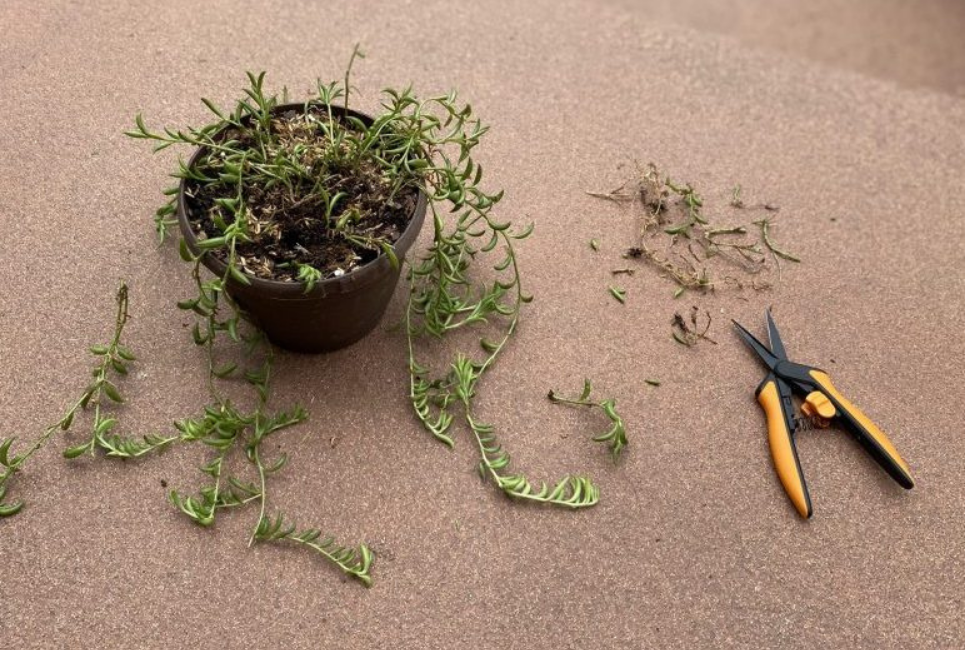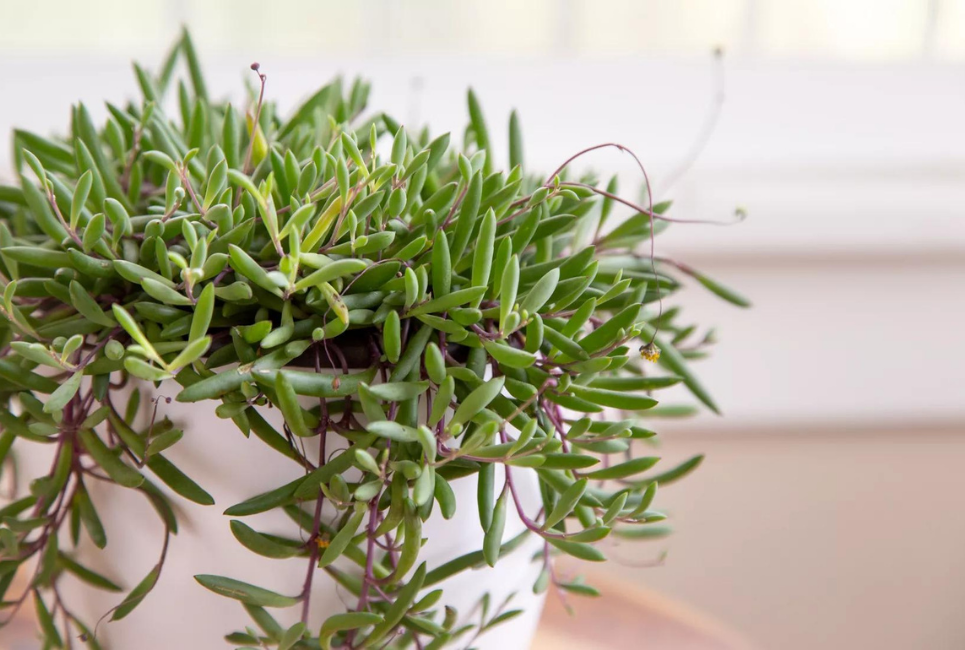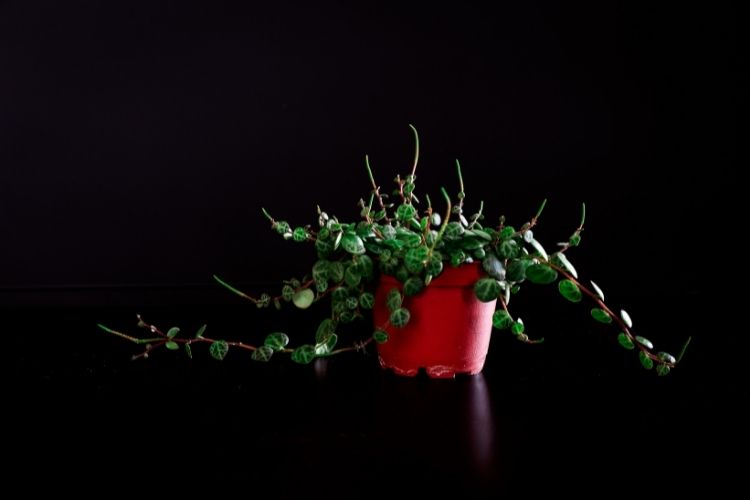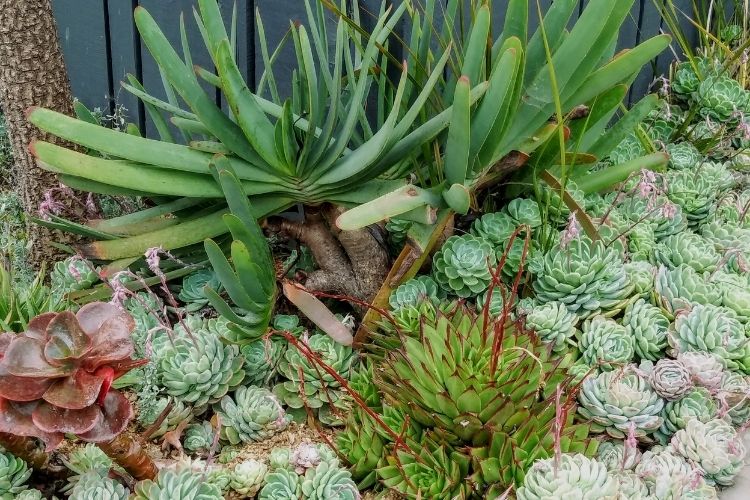The string of bananas succulents is absolutely incredible to behold. It is also a rather easy-to-care-for type of succulent that beautifies and designs a fun and funky atmosphere.
How to Identify String of Bananas
It is very easy to recognize a String of Bananas succulent due to the fact that it legitimately looks like tiny green bananas growing on a string. At first glance, it might look like green beans gone wild but upon further inspection, the little pod-like leaves are shaped more like a banana than a green bean.
Where Does String of Bananas Grow
These unique-looking plants are indigenous to South Africa, and therefore, enjoy plenty of warm sunlight and arid soil. They grow their best when kept in soil that has a pH level of 6.6 to 7.5. If grown outdoors, they can only survive winter weather when planted in USDA hardiness zones 10 to 12.
If they are grown in a different zone, they will need to be kept in a container that can be transported indoors during cold weather.
Uses of String of Bananas
String of Bananas is an ideal plant for hanging baskets or setting on top shelves so that its vines can dangle unimpeded. They are very decorative even when they are not in bloom so they will bring a lovely and rare design to any place where they are featured.
How to Grow String of Bananas From Seed

Propagating String of Bananas from seed is a long and difficult process, so most gardeners choose to propagate through stem cuttings since that option is so easy. But, if you are game to try, here are the basic steps to follow:
- Plant the seeds in a pot filled with potting soil designed for succulents
- Place the pots in a tray filled with water so the soil will absorb the water from the bottom
- Place the tray of pots in a warm area with indirect sunlight
- Place a piece of plastic wrap over the pots to keep in air humidity
- Add water to the tray as needed
It can take anywhere from a few weeks to three months before you will see any signs of successful germination from the planted seedlings. Evidence that the seeds are sprouting will be tiny leaves above the soil. As soon as these leaves are spotted, the plastic wrap should be removed.
Once the seedlings have grown into healthy plants, the following care must be taken:
- Move the new plants to a larger pot, if needed
- Feed the new plants with a diluted fertilizer during their growing season. This is usually springtime.
- Water the plants only when the soil is dry.
String of Bananas Growing Conditions
For these plants to grow and thrive, they will need to be set in a place with partial sun to partial shade, plenty of warm air, and well-draining soil.
When to Plant String of Bananas
Spring and Summer are the best times to plant or repot String of Bananas. These are the times of the year when there will be the best amount of sunlight and heat. When kept in a container, they will require a new batch of soil every few years so that they get the nutrients they need.
How to Plant String of Bananas
These succulents are very easy to plant when you use stem cuttings. The steps for doing this are:
- Cut off a stem from the main plant with a sharp, sterile cutting utensil
- Let the stem dry and callous for a few days
- Fill a container with succulent potting mix
- Place the offset into the container (you can put part of it in the soil or just lay it on top of the soil)
- Give the new plant a drink
- Set it in a warm sunny place
String of Bananas Water Requirements

The water requirements of String of Bananas are typical of most succulents. Since this plant is susceptible to root rot, it is best to use the soak and dry method when watering it. The steps for doing this are as follows:
- Fill a tray or a sink with a few inches of water.
- Set the plant container in the tray making sure that the water is not so deep that it will run over the top of the container. The point of watering in this way is so that the roots will soak up the water and the leaves will not get wet.
- Let the plant soak in the water for fifteen minutes. This will allow the root system to soak up water from the bottom of the container.
- Take the plant container out of the water.
- Place the plant container in a spot where the excess water can drain from the hole in the bottom.
- Repeat this only when the soil around the plant is dry.
String of Bananas Sun Requirements
Plants that are kept indoors will need to be placed in a window that gets at least six hours of bright, direct sunlight each day. If this is unavailable indoors, this plant does well under grow lights. Plants that are kept outdoors will do well in partial shade to partial sun.
Best String of Bananas Fertilizer
Like most succulents, String of Bananas doesn’t usually require fertilizer. However, fertilizer can be used at times to encourage healthy growth during the spring and summer months. The best types of fertilizer for this succulent are worm compost, liquid kelp, or fish emulsion.
Try GS Plant Foods’ Organic Liquid Kelp to encourage your String of Bananas to grow strong and healthy. It is a completely natural fertilizer option that is designed to help plants grow to their fullest.
Best String of Bananas Companion Plantings
These hanging succulents are so lovely by themselves that it is hard to believe that they can actually look any better, but the truth is, they actually do. Try pairing your String of Bananas plant with one of these complementary hanging succulents.
String of Turtles

This is an adorable succulent from the rainforests of Brazil. It, too, is perfectly named to describe its tiny turtle shell leaves. Not only will it look great next to a String of Bananas plant, but it will also take just as much effort to care for it.
Pros
- Does not require fertilizer
- Grows well in indirect sunlight or with a grow light
- Can handle moisture better than most other types of succulents
- It is a small plant that is perfect for decorating living spaces
Cons
- It is toxic to animals
- Its temperature needs are different from String of Bananas (it requires cool humidity)
- Its soil needs are different from String of Bananas (it requires acidic soil that is rich in peat)
String of Dolphins
This little plant looks like a pod of dolphins jumping around. It is very playful and would make a great companion for a String of Bananas plant.
Pros
- It is easy to grow and care for
- It does not require regular fertilizing
- It can grow in medium amounts of sunlight or under a grow light
- It is drought-tolerant
Cons
- It can easily be overwatered
- It is not frost or cold tolerant
- It is toxic to humans and animals
String of Rubies

This is another trailing succulent that will look lovely next to a String of Bananas plant. It also has the unique feature of turning red under healthy stressors.
Pros
- It does not require regular fertilizing
- It can grow in medium amounts of sunlight or under a grow light
- It is drought-tolerant
- It is easy to replant and propagate
Cons
- It is sunlight and temperature-sensitive
- Its toxicity has not been listed
String of Bananas Diseases and Common Problems
This plant is susceptible to pests and diseases that are common to all types of houseplants. The things that should be watched for the most are:
- Root rot from overwatering
- Aphids
- Mealybugs
- Scale
- Spider mites
String of Bananas Treatments and Maintenance
If you begin to notice that your String of Bananas plant is not as healthy and vibrant as it once was, it may be time to check the plant. It may be suffering from an infestation of pests or from root rot.
Root Rot
The signs of root rot in a plant are yellowing leaves, wilted leaves, mushy leaves, and/or a rotting smell. If any of these signs appear in your plant, you need to take action immediately. The basic treatment for root rot is:
- Allow the plant to dry out: This technique can be done if the root rot has not spread to the stems. What it entails is taking the plant out of the soil and letting them layout for a few days so the excess water will evaporate. Once this has been done, they should be replanted in fresh, clean, and dry soil.
- Remove any of the rotten parts of the plant: Trim off any areas of the plant that are rotting, then allow the plant to callous for a few days. Without letting it callous, the chances of the succulent surviving are very slim.
- Add some sulfur: This technique should be done after the plant has been trimmed of all its rotted areas and allowed to callous. It will require that you dust a little sulfur on its root system to help prevent the spread of microbes.
- Behead the plant: This is the last resort technique, but if this is the method that you feel is necessary for your rotting plant, this video can help you through the process.
Dealing with root rot is a very difficult process that doesn’t guarantee success, so it is always best to prevent it from even occurring. To prevent root rot, take the time to learn how to properly water a succulent.
Aphids
These little insects are usually green but can come in a variety of colors. Their most prominent feature is that they are fat and teardrop-shaped.
If you notice these insects on your plant, you can use a mixture of soapy water and vegetable oil to spray the infested areas. Neem oil can also be applied to the leaves of the plant to help remove the insects and prevent them from returning.
Mealybugs
If you notice white fluff growing on your plant, you may have a mealybug infestation. To rid your plant of these pests, apply rubbing alcohol to any places on the plant where you see the white fluff or the actual insects. There is also the option of spraying the plant with a solution of diluted dish soap and water.
Mealybugs can also be hiding in the roots of the plant. If this is the case with your String of Bananas plant, it will require that you remove the plant from its container, shake off the soil, wash the roots with diluted alcohol or soapy water, allow the plant to dry, and then, replant it in new, fresh soil.
Note: Ridding your plant of mealybugs may take a few treatments over several weeks.
Scale
These are tiny insects that will appear as small, brown bumps on your succulent. If you notice these, remove the visible insects and start cleaning the plant with diluted alcohol or soapy water. If the roots of the plant have been infested, you can clean them in the same manner that you would in the case of a mealybug infestation.
Spider Mites
The sign of an infestation of spider mites is that the plant will turn a lighter color, even white or silvery. There will also be brown spots and spider webbing on the plant. If you notice any of these signs on your plant, treat the infestation just as you would an infestation of mealybugs.
String of Bananas Repotting Instructions
The process for repotting one of these plants is simple. Here are the steps:
- Find a container for the plant
- Add some potting soil to the container
- Gently set the plant into the potting soil or on top of the potting soil (the stems will grow new roots of their own)
- Give it a drink
- Set it in an area where it can get indirect sunlight
Where to Buy String of Bananas Seeds Online
Since these succulents are usually propagated by stem cuttings, buying their seeds online is not as popular as buying the actual plant. That does not mean it is impossible. If you are interested in propagating one of these plants from seeds, try this online shop.
Where to Buy String of Bananas Plants Online
There are plenty of wonderful online shops where String of Bananas plants can be purchased. These three online shops offer a great selection.
FAQs
Question: Is String of Bananas Toxic?
Answer: Unfortunately, these plants are toxic to cats and dogs. They can also be harmful to humans if ingested. This is why it is often recommended that String of Bananas be kept on a high shelf or in a hanging planter so they are not easy for pets and small children to reach.
Question: What Are the Symptoms of Poisoning by String of Bananas?
Answer: If you notice that your pet or child has any of the following symptoms, you should contact your doctor or veterinarian immediately.
– Nausea
– Vomiting
– Irritation of the skin
– Drooling
– Loose bowels
– Sluggishness
Question: Are There Any Trailing Succulents That Are Not Toxic?
Answer: If you are looking for a non-toxic trailing succulent, consider Burro’s Tai as the ultimate choice. Its needs are the same as other types of succulents and it looks wonderful in a hanging basket so it is the perfect option for those who need a toxic-free but trailing succulent.
Concluding Thoughts
This plant is the ultimate when it comes to uniqueness. Its features are delicate yet fun. Its care needs are easy and straightforward. Its benefits are numerous. If you are looking for a statement piece in your home or garden, then look no further than a String of Bananas plant.
Research Citations
- Succulents and Sunshine
- The Spruce
- Joy Us Garden
- Gardening Know How
- Succulent Growing Tips
- My Tasteful Space
Learn more about taking care of your plants below:
- 5 Best Hanging Succulent Varieties That Are Must-Have
- Ceropegia Woodii Variegata (Variegated String of Hearts) How To Grow Them Lush
- Disocactus Anguliger (Fishbone Cactus): How To Propagate and Grow
- Lophocereus Marginatus (Mexican Fence Post Cactus) - January 10, 2022
- Best Cactus Fertilizer Guide - January 9, 2022
- Selenicereus Grandiflorus (Queen of the Night) - January 3, 2022


